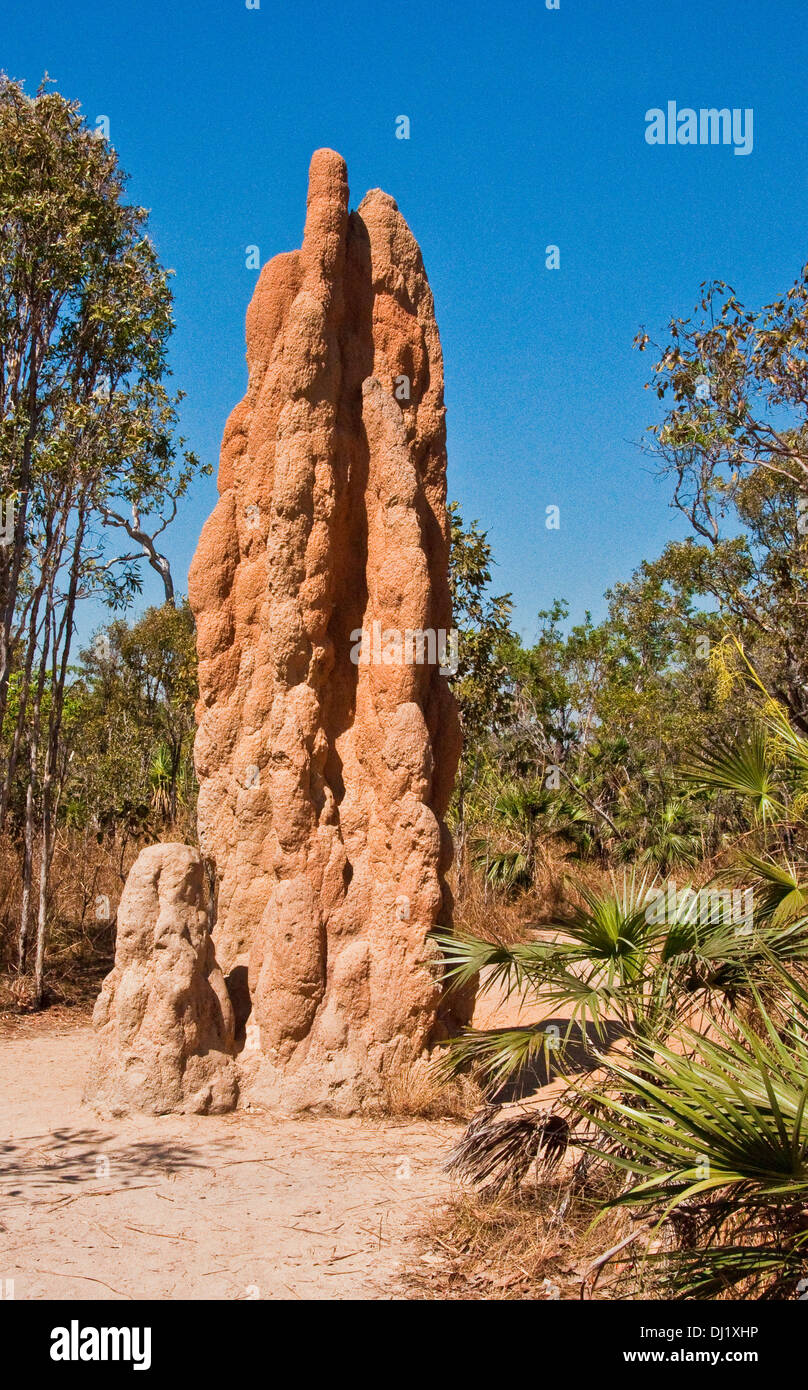
5 Highlights of Litchfield National Park, Northern Territory
Bronze Flat Butterfly White-banded bees Predators, parasites and parasitoids Sydney Hawk Dragonfly European wasp Crusader Bug Doubleday's Footman Marbled Footman Anestia semiochrea (Butler, 1886) Sydney Gum Leaf Katydid Purple-winged Mantid You may also be interested in.

"Termite Mounds, Litchfield National Park, NT, Australia" by Friedrich Redbubble
Magnetic Termite Mounds Accommodation Tours Believe your eyes as you survey hundreds of two-metre-high termite mounds standing upright in the same direction, like enormous magnetic compasses.

termite mounds near tennant creek, northern territory, australia Stock Photo 41416196 Superstock
Termite mounds in the Northern Territory. Researchers have found cathedral termites descend from tree-nesting termites that arrived in Australia up to 20m years ago from Asia or South America.

Termite mounds can halt desert's advance study
Termites thrive in open savannah woodland and survive on grass. The mounds can live for around 50 to 100 years, and the queen lives for the entire life of the mound. Discover the Captivating Magnetic Termite Mounds The Cathedral Termite Mounds are located about 17km from the eastern edge of Litchfield National Park.

Termite Mound, Outback, Australia, by Jim MacLaren Australian photography, Australia, Outback
Termite mounds built by representatives of the family Termitidae are among the most spectacular constructions in the animal kingdom, reaching 6-8 m in height and housing millions of individuals.. This group is one of the most ecologically successful groups of termites in Australia . We have shown that its capacity to disperse over oceans.

The Animal House The Incredible Termite Mound Nature PBS
Referred to as "cathedral" termites, the Nasutitermes triodiae build huge mounds up to eight metres high in the Northern Territory, Western Australia and Queensland - representing some of the.

termite mounds in northern territory, australia Stock Photo Alamy
Amitermes meridionalis, commonly known as the magnetic termite or compass termite, is a species of eusocial insect in the family Termitidae. It is endemic to northern Australia and the common names derive from the fact that the wedge-shaped mound is aligned with its main axis running north and south. [1] Description

Cathedral Termite Mound
Magnetic Termite Mounds Litchfield National Park Litchfield Park, Australia Let these towering termite-building structures tell you where to go. Been Here? 31 Want to Visit? 42 Explore.

Queensland Termite Mound,Australia Stock Image Image of termite, build 54465541
Structures built by small insects that rise up to two metres and beyond in Australia's natural parks. Cheesy photo to show scale… Driving To Litchfield Park to Find the Termite Mounds The earth turned rust red while the sky scratched deep into the blue pools in my eyes. Grass scrubbed the land and burning dust scrubbed my lungs.

Australia Termite Mounds in Exmouth Travel2Unlimited
Our findings are nevertheless likely to extend to many Australian mounds, given the sampling site is broadly representative of much of tropical northern Australia [7, 93] and the three termite.

Termite mounds, outback Australia Stock Photo Alamy
AUSTRALIAN TERMITE MOUNDS February 4, 2019 Would you be able to identify the nest mounds of these Australian termite species? Researchers have recently discovered that the vast termite mounds that cover the caatinga forests in northeastern Brazil are up to 4000 years old.

Giant Termite Mound in Australia Stock Photo Image of kakadu, territory 98912914
Termites. Termites are responsible for some of Kakadu's most spectacular structures - huge pointed mounds that tower up to six metres high. Made of mud and termite saliva, these mounds are incredibly solid and can last up to 60 years. Inside each one is a network of tunnels that is home to millions of hardworking insects.

Termite Mounds Northern Territory Australia HighRes Stock Photo Getty Images
The 'magnetic' termite mounds of monsoonal northern Australia built by Amitermes meridionalis are notable for their elongated wedge shape and north-south axial orientation. We tested whether the shape is an adaptation to facilitate gas exchange and the preservation of food stores by two experimental manipulations of mounds in situ.

Cathedral Termite Mound, Australia Photograph by Phil Hill Fine Art America
Estimates have been made that termites comprise nearly 10% of animal biomass in the tropics, where they are most diverse and abundant, and are responsible for >55% of decomposition ( Bignell, 2006; Jones and Eggleton, 2010; Griffiths et al., 2019 ).

Australia Termite Mounds in Exmouth Travel2Unlimited
A team of researchers led by Dr Philipp Nauer from the School of Ecosystem and Forest Sciences at the University of Melbourne has developed new techniques to understand all levels of the methane cycle in termite mounds in the tropical north of Australia.

Largest Termite Colony Termites Info
One of Litchfield National Park's most impressive sights is the hundreds of Cathedral and Magnetic termite mounds, some stand as high as two metres. Up to 100 years old these structures are unique to northern parts of Australia and Litchfield National Park in particular.